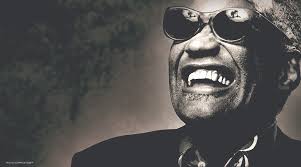This is Faith Lapidus. And this is Doug Johnson with PEOPLE IN AMERICA in VOA Special English. Today we begin a two-part report about singer, songwriter, and musician Ray Charles. His work will continue to have a lasting influence on American music.
Ray Charles spent almost sixty years as a professional musician. Millions of people around the world enjoy his recordings. If Ray Charles only played the piano, he would have been considered one of the best. If he had only sung his music, his voice would have made him famous. If he had only played jazz music, the world would have listened. But Ray Charles did all these things and more.
He played and sang rock-and-roll and rhythm-and-blues songs. He sold millions of country and western records, too. His work brought together different kinds of music and different kinds of music fans. His influence on much of America's popular music cannot be truly measured.
That was Ray Charles and "One Mint Julep." He recorded that song in nineteen sixty-one on an album called "Genius Plus Soul Equals Jazz." It is one of the many hundreds of records he recorded.
Ray Charles Robinson was born in nineteen thirty in Albany, Georgia. When he was six years old, he began to suffer from the eye disease glaucoma. The disease made him blind. He left the world of sight forever and turned to the world of sound. He learned to love sounds, especially music of all kinds.
Ray Charles taught himself to play the organ, alto saxophone, clarinet and trumpet. Yet there was a special relationship between him and the piano. Here is part of the song "Worried Mind." The style is country and western, with a heavy influence of blues. Listen to his work on the piano, an instrument he truly loved. You can almost see him smiling.
Ray Charles was fifteen years old when his mother died. Within a year, he had left school to work. He began playing piano professionally in African American eating and drinking places in the state of Florida.
A year later, he moved to the opposite corner of America: Seattle, Washington. While in Seattle, he made forty records. But none was a success.
At that time, Ray Charles was trying to play the piano and sing like the famous performer Nat King Cole. But he quickly learned there was only one Nat King Cole. No one wanted to hear a copy, not even a good copy.
So Charles started looking for his own musical sound. He began to experiment. He tried mixing blues and jazz. He used some jazz styles with the music that later was known as rock-and-roll. His experiments soon became popular with many black Americans.
He played at dances around the country. He also sold some records, mostly to black people. Few white Americans had heard of a blind musician named Ray Charles.
By the middle of the nineteen fifties, he had his own band. It was one of the most popular black dance bands in the country. A group of women sang with the band.
One night, Charles began playing a simple song. He told the women to sing in a style known as call and response. In this style, the lead singer asks a question or sings some words. The other singers answer. This kind of singing was brought to America by black slaves from Africa. It has remained very popular in black church music.
At the dance that night, Ray Charles put together simple piano music, traditional call and response and rock-and-roll. The result was a revolution in American music. Soon after, Ray recorded that song. It is called "What'd I Say?"
"What'd I Say?" sold millions of copies. Ray Charles no longer just played at small dances for black people. He performed in large theaters for big audiences of every color. He had found a sound like no other. His style of music was filled with excitement. And those who listened shared in that excitement.
By the end of the nineteen fifties, Ray Charles had recorded many hit songs. Most of his music was black rhythm-and-blues or soul music. Yet white Americans were listening, too.
Charles did not want to play just one kind of music, even if it was extremely popular. He began experimenting again, this time with jazz. One album, "Black Coffee," is considered by experts to be one of his very best jazz recordings. It shows that his piano work can express many different feelings. Here is the song "Black Coffee" from that album.
Ray Charles continued to make rhythm-and-blues and jazz records. But that was still not enough for him. He had always loved country-and-western music. So he decided to record a country album.
Music industry experts said he was making a mistake. They told him not to do it. They said he would lose many fans. The fans, they said, would not understand or like this kind of music. Ray Charles did not listen to the experts. He took a chance. And he was right. The public loved his country-and-western songs. You can hear some of these country-and-western songs next week, when we bring you the second part of our report about Ray Charles.











